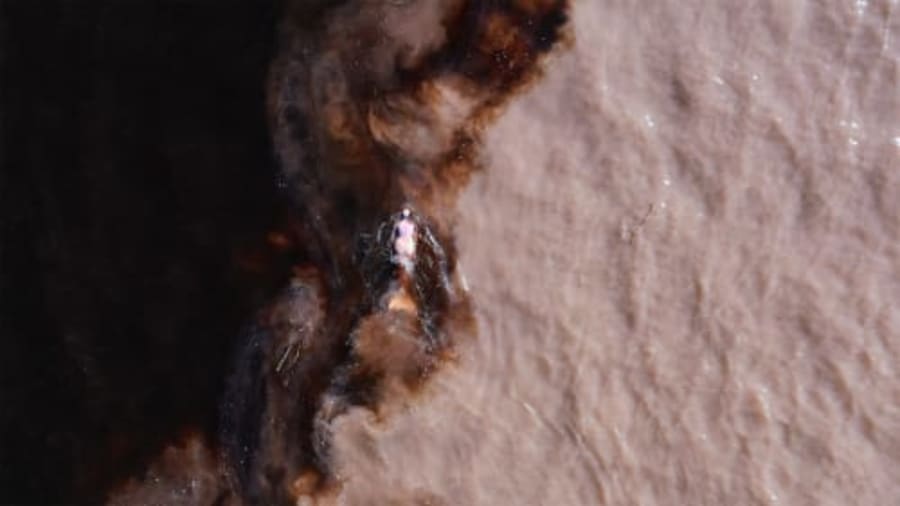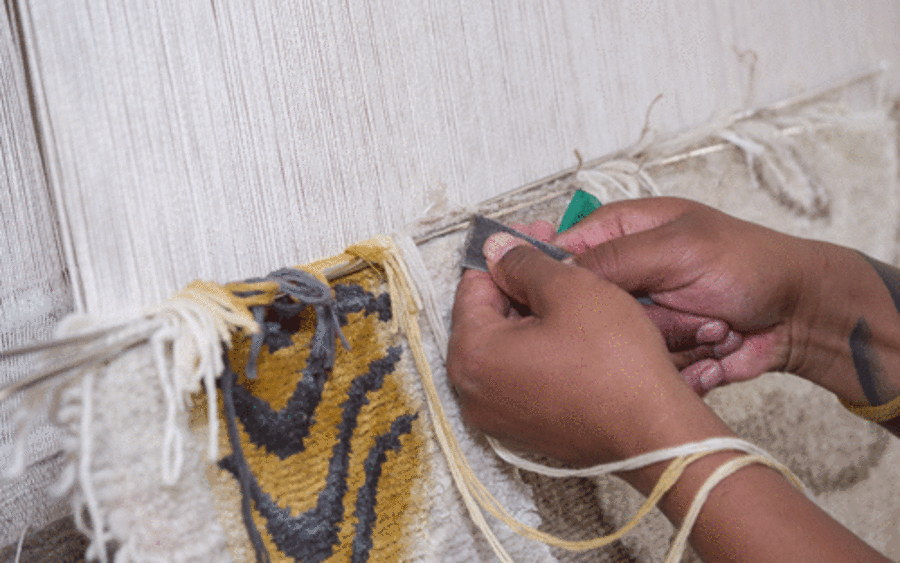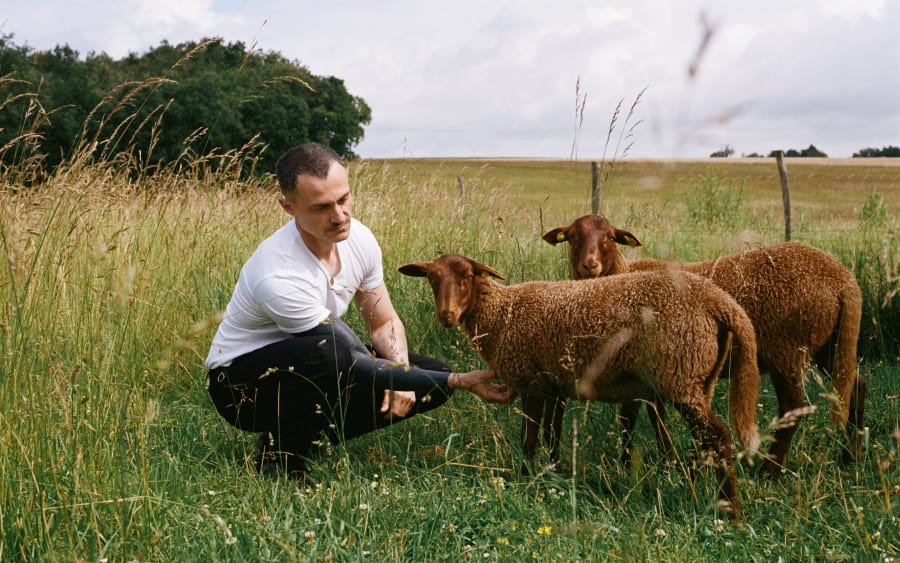Martha Atienza places Our Islands 11°16’58.4"N 123°45’07.0"E (2017), within the context of a community-based practice dedicated to finding ways to live with land, sea, and community. Displayed across Times Square’s iconic electronic billboards as part of ‘Midnight Moment’ this July, the film was created with underwater compressor divers from Atienza’s native Bantayan Island, which lies between the Visayan Sea and the Tañon Strait. Bringing attention to the challenges sea peoples face in the 21st century, divers perform a procession on the seafloor modeled after the annual Ati-atihan parade wearing items referencing religious, animistic, and pop cultures, from Manny Pacquiao’s boxing gloves to the costume of Santo Niño. She speaks to Art Basel about the work.
‘Our Islands... was a result of working with my family, neighbors, and friends in Lawis, Bantayan, since 2010, with the first project I did returning to Bantayan, My Navel is Buried in the Sea (Gilubong ang Akon Pusod sa Dagat). I filmed men I grew up with on Bantayan, trying to understand my father who came from this island in the middle of the Philippines and who ended up traveling the world. How did he see the world and how did he look back at the island he grew up on? The first international seafarer I filmed was my brother, Joel, working on a riverboat traveling between Germany and Holland. I then got on other cargo vessels to film men I grew up with on Bantayan.
‘What started out as the simple idea of trying to understand my father soon became a way for all of us on Bantayan to start difficult dialogues around family and community. There was always an abundance of fish in the waters of the place where we are from. When my father was growing up here in the 1940s and 1950s my lolo used to tell him that there was no need for him to leave because everything they needed was here. My father was one of the first international seafarers from the island who worked his way up to captain. His story is of a young boy who cleaned the shoes of Chinese migrants on Bantayan before he moved to Manila to work his way through maritime school. His first international route was Japan-Philippines. But that is a story for another time.
‘After my father, many more sons of fishermen became international seafarers. There was even a maritime school here for many years with over 600 seafarers graduating each year. But what impact did this have on our fishing community? Were we still a community? As international seafarers started to build their gated and cemented houses, their fishermen friends and neighbors started to feel disconnected. From 2010 to 2012, we organized screenings of moving images of both international seafarers and local fishermen working at sea that started dialogues around the many issues we faced: growing up without fathers, huge income gaps, the dangers of working at sea, including the desperate way compressor divers work to get the catch they need to feed their families and make enough to send their children to school, with some of them becoming international seafarers.
‘The questions that occurred then and are still relevant today, include: Are we developing for the better? Are we still a community that helps one another? How do we preserve who we are but move with our time? But also: Can art trigger social, environmental, and even economical change here on Bantayan?
‘I jump to when I showed Our Islands... in 2017 at Statements at Art Basel with Silverlens, when we won the Baloise Prize. The conversations that this work brought about not just on Bantayan but across the oceans have been a success story in a way, but the state of fisherfolk has only worsened with climate change, rising sea levels and temperatures, and extreme weather. The system is also failing us. How do we protect our culture and our fisherfolk and farmers? They play such an important role in our food security and yet they seem to be on the frontline of climate change, social injustice, and politics. This is really how I shifted from using art as a way to open up difficult dialogues on the islands to formalizing our efforts and recognizing our process as a methodology for change.
‘My family has always been involved. My younger brother, Jake, has been working with me on these projects from the beginning, focusing on organizing the dialogues, running surveys, researching, and writing about our methodology for his B.A. thesis, which have become the backbone for our Coconut Tree Methodology that we are applying to GOODLand. We formalized GOODLand in 2020 during the pandemic to develop methodologies to tackle social, economic and environmental issues on Bantayan while seeing how local solutions translate globally. A lot of overseas workers returned home during the pandemic, as well as people working in cities, and people started growing vegetables at home. They realized we could grow our own food and saw how important our sea is for our survival. We reconnected with our natural resources on our own islands. We had people join our team that wanted to share their skills for everyone on the island.
‘The first time Jake and I filmed together was in 2007, when typhoon Reming hit Albay causing heavy landslides that washed villages into the sea. We were there to film for an NGO, who were making sure people had safe drinking water by creating biosand filters. Ever since, we’ve been working on most of the projects on Bantayan Island together, with me mostly on the ground and him from a distance. Our Islands... is actually a project that came about from an exchange of experiences, where I focused on Bantayan, while Jake was living and working in Australia, and doing research in Aotearoa (New Zealand) and the Kingdom of Tonga, eventually attending grad school in Hawaii. This work is about connecting to other island nations; about creating and sharing models to deal with climate change and the protection of our land, sea and people and using our seafaring cultures and learn from one another. One ocean, one people. Jake and I also work together as DAKOgamay, which translates to big, “DAKO,” and small, “gamay,” an experimental platform connecting to large issues through small actions on the ground. Marian Pastor Roces talks about this. Just because a problem seems too large to deal with, that does not mean projects responding to it need to be as big.
‘My brother and I have come to acknowledge that the process we have created working together is a tool. All our years of documenting stories, dialogues, activities, and collaborations we now see as an archive-based counter-mapping that can be used for the different outputs. Our archive is made by the communities we work with, our neighbors and friends, and gives evidence of our culture being alive and complex and that this proof can be a way to protect our culture, sea, and land.
‘As an example, during the pandemic we started working with our neighbors in the watershed area. Here in the Philippines, when you are from the “bukid” (inland farmlands) or “bay-bay” (coastal areas) and are farmers or fisherfolk, people might look down on you and see you as uneducated. We started coming together and doing sharing sessions about our place here and who we are, exchanging knowledge on the importance of these areas to our ecosystem here on our group of islands, and identifying the importance of native animal and plant species. The young people soon started to design their own workshops, inviting other neighboring young people, every time moving further out and eventually doing exchanges with coastal area youth. This turned into monthly workshops where inland and coastal youth share knowledge about forests and sea as food and healing sources. We now have everyone in the watershed involved; with elders sharing their knowledge of farming, seedbanks, and their history.’
Our Islands 11°16’58.4 N 123°45’07.0 E runs through July 31, nightly, on Times Square between 11.57 pm and 12 am.
Martha Atienza is represented by Silverlens.
Stephanie Bailey is Art Basel’s Conversations Curator, Art Basel Hong Kong, as well as the Art Basel Content Advisor and Editor, Asia.
Caption for top image: Installation view of Martha Atienza’s Our Islands 11°16’58.4”N 123°45’07.0”E (2017) at Art Basel in Basel 2017 at Statements sectors, presented by Silverlens.
Published on July 9, 2024.


